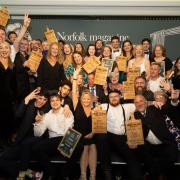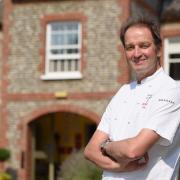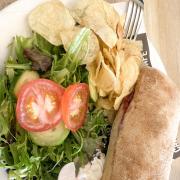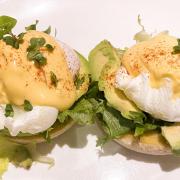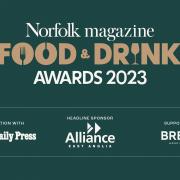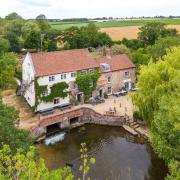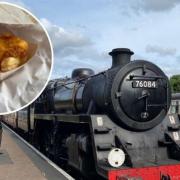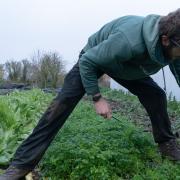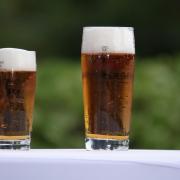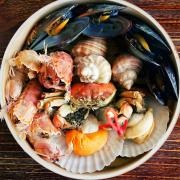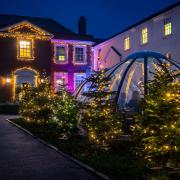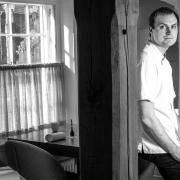Gleaming sea bass, fresh from the Lowestoft day boats, is an ingredient Mark Dixon puts on his Kindreds’ menu whenever the season allows

Mark Dixon’s new restaurant may be miles inland, but the Norfolk coast is never far from his mind – or his menu. Kindreds, which opened last year in the centre of Wymondham, reflects the richness of the North Sea’s bounty.
“Fish is always a big seller,” Mark says. “Plenty of people don’t realise just how lucky we are in Norfolk and what we can get from this coastline. I try and get to Lowestoft every so often, to refresh my memory, be among the hustle and bustle of the fish market, be inspired anew by the fish that’s being caught.”
It’s May, and wild sea bass, caught on the long line, is coming into season, the fish plump, silver-sparkling and glossy. “Wild sea bass is so versatile, and the fish I get is so fresh you could even do a cured ceviche with it,” Mark says. “It even stands up to a red wine sauce – in winter we do a fantastic dish with parsnip purée, shallots, girolles and a red wine and veal reduction.
“I cook cod all-year-round, a real favourite with me and the diners, and I love mackerel and turbot. You don’t see that one on many menus these days because it’s expensive, but I want to serve something our guests definitely wouldn’t cook at home.

“They expect a bit more now, and that’s good, it keeps us on our toes!” It goes without saying that Mark always cooks with the seasons. Early summer samphire and brown shrimps complement sea bass perfectly, the vivid green of the sea vegetable contrasting strikingly with golden saffron potatoes. He serves it with a silky chive beurre blanc, fresh pea shoots and tiny flowers to garnish.
Mark was born in Great Yarmouth. He started out as an apprentice chef at the town’s family-run Imperial Hotel, where he quickly felt he could learn more in a day than in two months on day release from the town’s college.
“I got a bit bored at college,” he says, “and they kicked me out. “Things have a habit of coming full circle though, don’t they - now I give lessons there!” Eight of his 14 years at the Imperial were spent learning classical cooking skills; the other six he spent as head chef before stepping out on his own in 2013 to open his first restaurant, The King’s Arms in Fleggburgh.
Mark’s style is calm, precise, technical, accurate. Everything in the kitchen is measured down to the gram, the millilitre and the second.

Everything is made from scratch, from bread to sorbets to ice cream; nothing is bought on the cheap, which means that nothing can afford to be wasted.
“Taste is definitely the most important element of everything we do,” he says. “There’s no point in food being on a plate if it doesn’t taste of anything.
“With my dad being a farmer, I appreciate all the time and effort that goes into producing food. People respect food and animals around here, and loads of people have allotments. In the summer everything’s on the doorstep, especially in Fleggburgh.
“There, locals bring surplus produce to swap at the pub so there’s a really convivial, community atmosphere which I love.

“Here in Wymondham I’ve been using the town’s Friday market for bits and pieces – I’m not used to having shops at hand so it’s exciting for me!– and again I manage to find plenty of fantastic ingredients that have been grown within a very few miles of my restaurant.”
Wild sea bass, saffron potatoes, brown shrimps, samphire and chive beurre blanc
A delicious elegant but earthy expression of Norfolk’s coast and sea on a plate. You can replace the chives with shredded wild sorrel or fennel tops for a different herby edge. (Serves 4)

Beurre blanc
250ml dry white wine
250ml fish stock
250ml double cream
120g salted butter, diced and well chilled
Handful of chopped chives
Boil down the wine and stock until just two tablespoons’ volume remains. Whisk in the double cream, bring back to a simmer over a high heat and whisk in the butter, melting in one or two cubes at a time before the next, finally folding in the chives and keeping warm.
Saffron potatoes
12 new potatoes
600ml good chicken stock
Pinch saffron strands
Top, tail, and thickly trim the potatoes into curved cylinder shapes. Simmer in the chicken stock with saffron and seasoning. When tender after 10-15 minutes, drain and set aside somewhere warm.
To serve
Unsalted butter
Good rapeseed oil
200g samphire, trimmed
Four 120g sea bass fillets
100g peeled brown shrimps
Handful pea shoots
Blanch the samphire in boiling water until al dente, drain and put under cold running tap.
Heat up a heavy frying pan on a hot heat, add a knob of butter and a drizzle of oil. Once foaming place in the bass skin-side down, turn down heat to medium and cook until golden brown, (avoid touching it for first five minutes then check every two thereafter). Turn over, add in the potatoes and cook for a further five minutes, pull the pan off the heat and rest, while preparing the other garnishes.
Melt a knob of butter in another frying pan over a hot heat, add in the samphire and the shrimps, stirring well occasionally until piping hot.
To serve, spoon the hot sauce in the middle of warmed deep plates, add a bed of samphire and shrimps, plus three potatoes around the side and place on bass skin-side up, finishing with the pea shoots.
Norfolk ‘strawberries & cream’
We serve this dish of set vanilla cream pannacotta and strawberry jelly alongside zesty lime sorbet and brown sugar meringue. (Serves 4)
7 gelatine leaves
240ml double cream
60ml whole milk
40g caster sugar
1 vanilla bean, seeds and scraped pod
200g caster sugar
500g strawberries, dehulled and chopped
Soak two of the gelatine leaves in cold water. Dissolve the next four ingredients together in a heavy pan and bring to a simmer, remove and whisk in the strained gelatine. Sieve and pour into clingfilmed moulds. Chill in the fridge for at least six hours.
Soak the remaining gelatine leaves in cold water. Simmer the caster sugar and strawberries with 600ml of water in a heavy pan while stirring, then turn heat to low for 10 minutes. Remove and infuse for a further 10 minutes, straining through a sieve without mashing and leave to drain for five minutes. Stir in the gelatine, sieve into a jug and pour into a clingfilmed plastic tray. Leave to set for a minimum of 12 hours. Cut into cubes and serve with the turned-out creams.
Norfolk Table; One County, Twenty Chefs, by Tessa Allingham and Glyn Williams, is priced at £19.95 and available from Jarrold of Norwich book department and fine food retailers as wells as the 20 featured restaurants.





